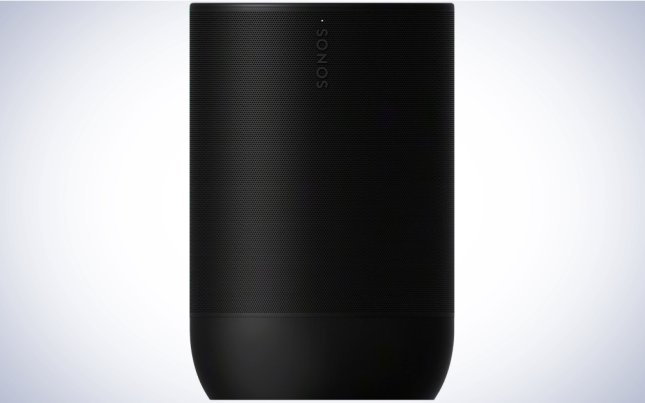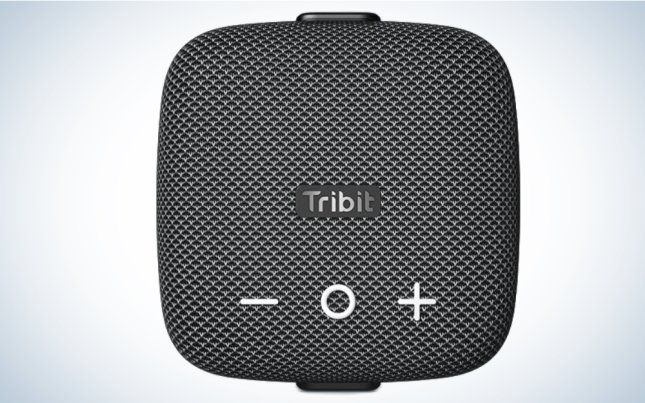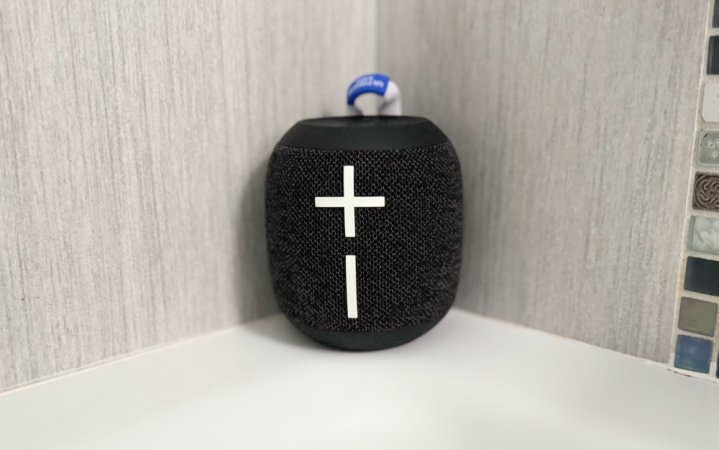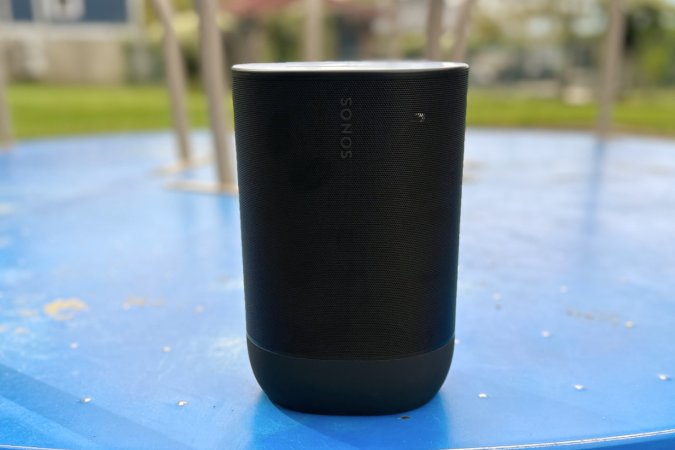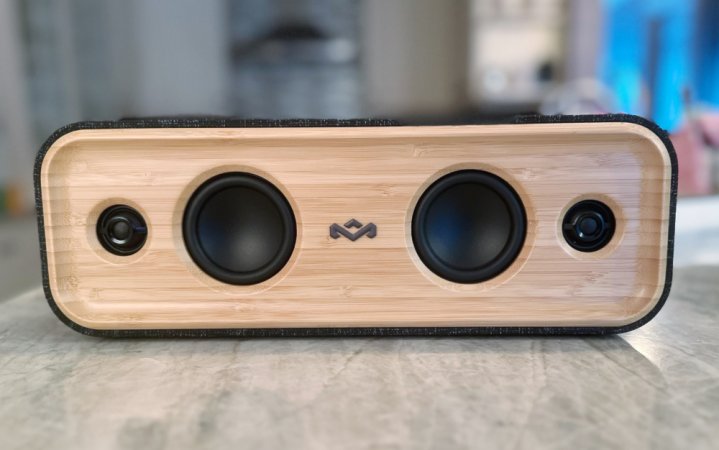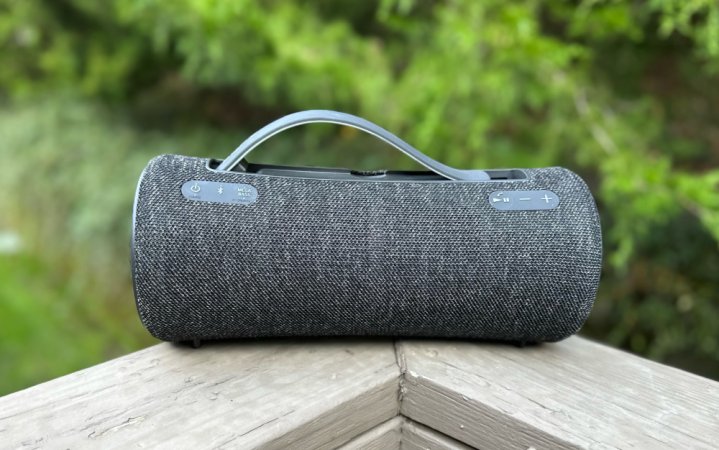We may earn revenue from the products available on this page and participate in affiliate programs. Learn more ›
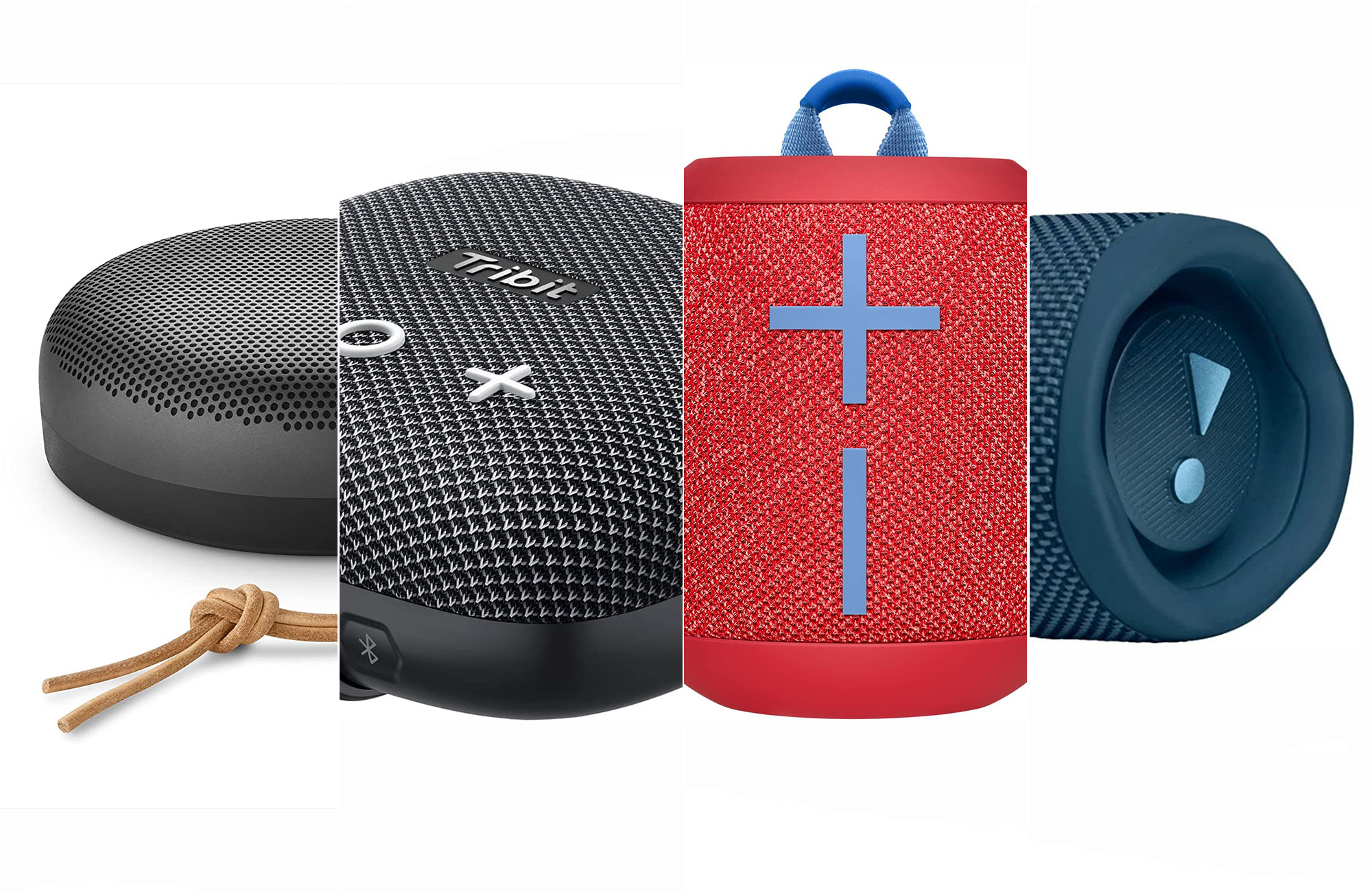
Waterproof speakers can pump out your favorite music any time, rain or shine. If you want to rock out in, near, or under the water, a great speaker that can play a smash even if it takes a splash is a must. And you don’t need to make any sacrifices for sound quality, nor should you have to bend on battery life, portability, and connectivity. We’re here to help you find the best waterproof speakers, whether you’re looking to blast Anderson.Paak’s “Malibu” at a pool party or sit in your feels during a Phoebe Bridgers shower session.
- Best overall: JBL Flip 6
- Best portable: UE WONDERBOOM 4
- Best indoor/outdoor: Sonos Move 2
- Best premium shower speaker: Bang & Olufsen Beosound A1 (2nd Gen)
- Best sustainable: House of Marley Get Together 2
- Best for Android: Sony SRS-XG300
- Best budget: Tribit StormBox Micro 2
How we chose the best waterproof speakers
We selected our favorite waterproof speakers by considering personal experiences with portable and powered and smart speakers of all sorts alongside other user impressions and then combining those with extensive research on top-performing models. We looked at Ingress Protection (IP) rating and other speaker specs—like frequency response and maximum sound pressure level—to ensure durability and sound quality. From there, we considered battery life, Bluetooth range, and special features to select the best from a fairly dense pool.
The best waterproof speakers: Reviews & Recommendations
Our selection of waterproof speakers comes from some of the best-known audio companies, in addition to impressive newcomers disrupting this space. Each speaker has its own standout feature, but we’ve balanced our picks to make sure there’s something for everyone regardless of feature set or cost. Because these speakers connect to devices over Bluetooth, a widely used technical standard, you’ll be able to pair them with any smartphone, tablet, or computer.
Best overall: JBL Flip 6
Best overall
Pros
- PartyBoost technology
- Bluetooth 5.1
- GraphicEQ
Cons
- No aux input
- Battery life is just okay
Why it made the cut: The JBL Flip 6 is a compact waterproof party speaker that sounds and looks great on the go or at home.
Specs
- Battery Life: 12 hours
- Bluetooth Range: approx 130 feet
- IP Rating: IP67
The JBL Flip 6 (which our reviewer loved) is a great portable Bluetooth speaker for any listening experience, dry or wet. With a durable build, rubberized onboard controls, and an IP67, this model is protected from more than just water; it’s protected against dust and drops, so you can feel confident taking it on any outdoor adventure. The Flip 6 has dual passive radiators, a separate tweeter, a purported frequency response range of 63 Hz – 20 kHz, and a max volume of around 87 dB, so you’ll be satisfied with the overall sound quality.
Plus, you can customize your audio using the graphic EQ on the JBL Portable app, available for both iOS and Android systems. This app also lets you connect your Flip 6 to another compatible JBL speaker with PartyBoost mode, increasing volume, creating a stereo pair, and widening coverage during larger gatherings. This model can only connect wirelessly via Bluetooth 5.1, however; it doesn’t have an aux, USB, or any other wired input. It does feature a USB-C quick charging port, which will come in handy if you like to listen at loud volumes because while the Flip 6 has up to 12 hours of battery life, that number can diminish if you’re blasting music.
Need an even bigger bump in battery and listening levels? There’s the equally IP67 Charge 5 or Pulse 5 or Xtreme 4 or any number of other JBL party speakers to choose from.
Best portable: UE WONDERBOOM 4
Pros
- Durability
- Volume
- Portability
Cons
- No microphone
Why it made the cut: The UE Wonderboom 4 has continued to top our charts when it comes to portable, affordable, waterproof sound.
Specs
- Battery Life: 14 hours
- Bluetooth Range: 131 feet
- IP Rating: IP67
The WONDERBOOM 4 is one of our favorite shower speakers thanks to its compact, ultra-portable design, and the new speaker is an excellent choice for anyone interested in upgrading to waterproof audio gear. It inherits a lot of great features from previous generations of the speaker, including 360-degree sound, 14-hour battery life, peak volume of 87dB (decibels), and a body made partially from recycled materials. Most critically, it maintains the WONDERBOOM 3’s IP67 durability rating, which means it can be completely submerged underwater without being damaged.
At peak volume, the WONDERBOOM 4 can blanket the area around a full-sized pool in great-sounding audio, even when you don’t enable its dedicated “outdoor” mode by pushing a button on its underside. It filled a mid-sized indoor room in our tests without pushing the speaker above 80% of its maximum volume. Other onboard controls will allow you to play, pause, and skip tracks without touching your phone, and we’re especially fond of its huge volume up and down buttons, which are easy to press.
This speaker weighs less than 1 pound and measures 4.3 by 3.8 inches with a flexible, looped handle to strap the speaker to a bike, bag, or belt loop for maximum portability. While it’s small, Ultimate Ears didn’t skimp on its audio features. This speaker has a pair of drivers and passive radiators, which allow it to play music in stereo and pump out an impressive amount of bass. Our listening tests included contemporary and classic music from multiple genres, and the WONDERBOOM 4 never failed to impress. It was even good at playing back spoken word audio without enabling its dedicated “podcast mode.”
If you need a waterproof speaker that’s easy to throw into your bag before heading to the pool and beach, this is the one to get. If you like these features but need a little more oomph, check out the step-up but still handheld model, the EVERBOOM, as well as the WONDERBOOM 4’s much bigger brother, the EPICBOOM—a big, bassy, shockproof, dustproof, waterproof device that can also be immersed in up to one meter of water for up to 30 minutes—or any of the other Ultimate Ears party speakers.
Best indoor/outdoor: Sonos Move 2
Pros
- Voice Assistant
- Sound quality
- Bluetooth range
- Expandable
Cons
- Pricey
- Does not natively support Siri
Why it made the cut: The Sonos Move 2 is a great speaker for mixed-use listening; it’s part of an expandable network that sounds excellent at home and transitions well for outdoor listening.
Specs
- Battery Life: 24 hours
- Bluetooth Range: 800 feet
- IP Rating: IP56
The Sonos Move 2 has an IP56 rating, as opposed to an IPX7 rating, which means that it’s not fully submersible but is protected from high-pressure water jets spraying in any direction. This essentially means it can withstand rain, steam, splashes, and the accidental dunk here or there. We still consider the Move 2 “waterproof” and while you don’t want to leave it floating in the pool, you can access impressive sound quality anywhere you go.
The Move 2’s biggest selling point is its incredible audio. The music we listened to sounded vibrant thanks to the speaker’s audio system, which features multiple drivers, a custom-designed amp, and a tasteful EQ. You can make changes to how it sounds within Sonos’ app, but we’re betting you’ll never need to. Additionally, the Move 2 supports a feature called TruePlay, which allows the speaker to automatically adjust its sound based on its location. This means the Move 2 will sound good both indoors and outdoors without you needing to lift a finger. The speaker is also easily transportable via its built-in handle, which encourages you to literally grab it and go..
You can connect to the Move via Bluetooth 5.0, AirPlay 2, or Wi-Fi, which, when used, will let you stream higher-quality, well-balanced audio and pair with other Sonos speakers to create a more robust stereo and/or multiroom sound system.
Wi-Fi also enables you to access voice assistants like Amazon Alexa, the Google Assistant, or one designed by Sonos itself. If you love the richly musical Sonos sound ecosystem but want something compact that you can submerge, check out the Sonos Roam 2, the Move 2’s highly recommended little brother with an IP67 rating.
Best premium shower speaker: Bang & Olufsen Beosound A1 (2nd Gen)
Pros
- Sound quality
- Bluetooth Range
- Battery Life
- Looped carrying strap
Cons
- Volume is a bit limited
Why it made the cut: The Beosound A1 is a well-constructed, portable, waterproof speaker from high-end brand Bang & Olufsen. It’s sleek and compact with a looped handle, perfect for hanging on a showerhead or resting atop a caddy.
Specs
- Battery Life: 18 hours
- Bluetooth Range: up to 800 feet
- IP Rating: IP67
While just about any of these speakers could support shower karaoke, the Beosound A1 (2nd Gen) has impeccable features and superb design; it measures approximately 5 x 5 inches with a flat bottom and features a looped candle so it can safely rest on a soap dish or hang from your showerhead.
Bang & Olufsen produces high-end audiophile favorites, so while this speaker is pricey, you’re guaranteed to get great sound from your purchase. When tested, the 360-degree driver and aptX Adaptive codec produce a wide soundstage and improved performance with an accurate frequency response between 63 Hz and 13.5 kHz. Audio is adjustable using the Beosonic app’s sound customization feature and five EQ presets.
Three omnidirectional microphones increase the clarity of phone calls, if you’re inclined to conference rather than just have a solo relaxation session. At the same time, built-in voice and onboard controls mean you can play, pause, skip, and more without reaching a sudsy hand out for your definitely not-waterproof phone.
If a compact speaker sounds like everything you need, but the Beosund’s price is prohibitive, check out the JBL Clip 4.
Best sustainable: House of Marley Get Together 2
Pros
- Made from sustainable materials
- Powerbank
Cons
- Price
- A little bass heavy
Specs
- Battery Life: 20 hours
- Bluetooth Range: up to 98 feet
- IP Rating: IP65
House of Marley’s Get Together 2 is a mid-sized waterproof Bluetooth speaker whose signature feature is that sustainable materials are used to make it. The speaker is made of bamboo, recycled plastic bottles, and recycled aluminum, and it comes in totally recyclable packaging. Not every material used for the Get Together 2 is environmentally friendly, but it’s far more sustainable than the other speakers we recommend.
As for its audio hardware, House of Marley designed the Get Together 2 with a four-driver system comprised of two woofers and a pair of tweeters, powered by a 40-watt amplifier. Its sound, while clear and loud, is a little bottom-heavy even on the Signature Sound EQ setting. It’s not that treble or midrange frequencies are squished—there are still a lot of details in vocals and drums—it’s just that bass is a lot more prominent. You can switch between three EQ modes (signature, bass boost, acoustic) by pressing a button on the back of the speaker, though we’d have liked to see more fine-grained controls available.
On the technical side, the Get Together 2 has many non-essential but nice-to-have features we’ve come to expect from a speaker in its size class, but not necessarily from waterproof models. Its USB-C port can charge other devices or quick-charge the speaker itself. The Get Together 2’s IP65 rating means it can be splashed or used in the sand without the risk of damage. Its 20-hour battery life may seem a little low compared to smaller speakers, but the Get Together Go 2 has more power-hungry audio hardware, so it’s in line with our expectations. If you care about both sustainability and sound, House of Marley’s Get Together 2 is a worthwhile portable speaker to pick up if you’ve got a $249 budget.
The company also offers a smaller $170 version, aptly called the Get Together 2 Mini, with an even better IP67 rating, two drivers, and a battery that lasts 15 hours.
Best for Android: Sony SRS-XG300
Pros
- Advanced-resolution codec support
- Portability for its size
- Loud sound
Cons
- Price
Why it made the cut: Sony’s SRS-XG300 is the only waterproof Bluetooth speaker we’ve found that supports the high-resolution LDAC codec.
Specs
- Battery Life: 25 hours
- Bluetooth Range: 98.4 feet
- IP Rating: IP67
Sony has never shied away from making high-end audio hardware, and the SRS-XG300 is its latest premium portable Bluetooth speaker—a waterproof one to boot. After years of refining internal components, Sony gave its portable speakers a much-needed top-to-bottom redesign. The SRS-XG300 is a lot sleeker, with a mesh covering pleasing to the eye and a handle that makes the relatively big speaker easier to carry. Indeed, carrying it from room to room or from the car to the beach never felt like a chore. Sony’s focus on building speakers with lights continues here, but they’re no longer a main focal point; LED rings surround the drivers on both sides of this speaker, but they never look garish, plus you can turn them off at the push of a button.
The SRS-XG300 is larger than most of our Bluetooth speaker recommendations, but the extra space has many big benefits. This speaker lasts up to 25 hours per charge while delivering far better sound than smaller speakers. This was the best-sounding portable Bluetooth speaker I tested this year, with refined-sounding lows, mids, and treble without distortion at high volumes. Sibilance and other audio abnormalities were also absent, though this will always come down to how your music was recorded and mastered. There’s even an integrated microphone w/ echo-cancelling technology if you want to use the SRS-XG300 as a crisp, natural-sounding speakerphone.
We can recommend the SRS-XG300 to anyone, especially Android users whose devices support the LDAC codec. Without getting too into the weeds, devices that support this technology can play advanced resolution audio at a bitrate of 990kbps (kilobytes per second), which is approaching 1,411kbps—what is considered full CD quality. For reference, aptX (a more commonly used audio codec) transmits audio at a maximum rate of 352kbps, and even the less compressed aptX HD is capped at 576kbps (though at an improved 48kHz). This difference doesn’t matter when you’re streaming music from Spotify, which streams at 320kkps. Still, it does if you’re using a compatible device that supports LDAC and listening to high-resolution audio files (or taking advantage of Apple Music, TIDAL, or Amazon Music’s higher tiers). TL;DR … LDAC audio sounds punchier and more precise, taking full advantage of the SRS-XG300’s X-Balanced driver technology.
Sony has always focused on audio quality, but the company has upped its game in the durability department this time. The SRS-XG300’s IP67 rating means it can be fully submerged underwater for a half hour and come out unscathed. We’d expect this performance from companies like JBL, which have been ramping up the durability of speakers for years, but it’s refreshing to see Sony take this so seriously.
All these features come with a steep price tag, however. Plus, the SRS-XG300’s most technically impressive feature is limited to folks with a handful of devices, so we couldn’t definitively label this the best portable Bluetooth speaker overall. If you care about audio quality, though, there’s no other portable Bluetooth speaker that deserves your consideration.
Like the cylindrical look with the LED lights and the LDAC codec, but want something even more powerful? The Sony ULT FIELD 7 is an IP67 party speaker for audiophile bassheads that is a bit longer than thigh-sized, with comfortable integrated handles on both ends. More importantly, the ULT BASS is ready to boost frequencies if you get high off lows. And you can even plug in a guitar/mic, if so inclined.
Best budget: Tribit StormBox Micro 2
Pros
- Price
- Bluetooth 5.3
- Powerbank
- Integrated strap
Cons
- Some distortion at loud volumes
- Limited onboard controls
Why it made the cut: Doubling as a portable charger, this compact speaker is a budget-friendly way to listen to your favorite tunes wherever the water takes you.
Specs
- Battery Life: 12 hours
- Bluetooth Range: up to 120 feet
- IP Rating: IP67
The Tribit StormBox Micro 2 is a super-compact second-generation model that delivers solid sound at an affordable price. Similar in size and design to its predecessor, this speaker measures roughly 4 x 4 inches with a rubberized, grippy bottom and durable, textured grill. Currently available only in black, this speaker is pretty sleek and discrete. The power and pairing buttons are integrated onto the front-facing side along with five tiny LED battery life indicators. Three streamlined control buttons top the speaker, and the multifunction circle allows you to play, pause, skip, go back; access Siri or Google Assistant; as well as answer, reject, and switch calls. The plus and minus buttons raise and lower volume.
Released in February 2022, this new and improved model is ready to roam with you. The integrated strap is also made of rubber with just enough stretch to fit around bulkier straps, handles, and more. It takes about two seconds to clip onto a backpack or bike handle and won’t accidentally fall off when jostled. With an IP67 rating, it’s ready for just about any terrain you might be traversing, withstanding dust and liquids. The battery can last up to 12 hours to stay connected all day or night; plus, the SmartID USB-C port used to recharge the StormBox Micro 2 can also charge your phone, tablet, or other small accessories. It’s a great speaker to bring on a short camping trip, long hike, day at the beach, or rafting adventure.
Primed to use right out of the box, you can quickly pair to your smart device using Bluetooth 5.3 technology, which also extends battery life, lowers latency, and increases range. It’s truly one of the more impressive connections we’ve seen—maintaining a strong signal even through layers of extra-thick, pre-war New York City building walls—the downfall of many Bluetooth speakers that came before the StormBox Micro2. With that same stable connection, you can add an additional StormBox Micro 2 to double volume and create a stereo pair.
The StormBox Micro 2 is tiny but surprisingly mighty, with 10 watts of output power, a 48mm NdFeB driver, passive radiators, and XBass technology making for a pretty solid listening experience. When tested, the volume reached 90 dB, which is plenty loud for outdoor listening. And while there was a bit of distortion at top volumes, the audio maintained overall clarity. There are about 16 level steps, leaving users feeling in control of their volume preferences.
When it comes to sound quality, this speaker delivers fairly solid sound. With a frequency response of 70 Hz – 20 kHz, you’ll notice that the bass is a little lacking. Desiigner’s “Timmy Turner” feels a bit lackluster when you can’t experience subbass vibrations; however, we’ve certainly heard worse low end from a compact speaker. Kanye West’s “808s & Heartbreak” feels satisfying with the speaker strapped to my backpack when I can get close to the thump of the passive radiator, though rattling drivers can occasionally distort midrange vocals. At the same time, Phoebe Bridger’s vocals on “Motion Sickness” sat nicely atop drums and guitar backing, and the harmonies on Queen’s “All Dead, All Dead” come through evenly.
The sound of the Tribit StormBox Micro 2 is more than adequate for a budget Bluetooth speaker that retails for under $100, and the extra features and fortifications up the value tremendously. If you’re looking for even more of a steal, though, you can try the Oontz Angle 3, which retails for under $40.
What to consider when buying a waterproof speaker
IP rating
The most important thing to check before purchasing a waterproof speaker is its IP rating. IP stands for “Ingress Protection,” which tells you how fortified an electronic device is against dirt, dust, and water. The first digit describes particle protection (dust or sand), and the second liquid. For example, if a speaker has a rating of IP57, the “5” indicates it can keep out most dust and dirt particles. The “7” means you can submerge the device in up to 1 meter of water for 30 minutes before any damage occurs. If you see a rating that looks like IPX7, the “X” means no data is available for that substance.
Only speakers with an IPX7 rating or higher can actually claim full waterproof status, though we have made an exception and recommended one stellar IP56 speaker. For full submersion or in-shower use, stick with IPX7 and above; however, an IPX6 can withstand a strong stream of water for a short time, about 100 liters per minute, suitable for rain, strong splashes, and more. IPX5 can handle 12.5 liters of water per minute, more like a squirt gun. IPX5 is technically water-resistant, and we don’t recommend trying out anything less if you’re on the search for a waterproof speaker.
Battery life
If you’re shopping for a waterproof speaker, chances are you’re preparing to take it on the go, which means you need a model with a long-lasting battery. Check out the specs and look for a model that can last between 10 and 20 hours so you don’t have to pause an outdoor adventure to charge your speaker inside. Generally speaking, larger speakers house longer-lasting batteries, but that’s not always the case. You should also note that most speakers drain their battery faster when playing music at loud volumes. So, if you know you’re about to host an all-day pool party, invest in something long-lasting because that speaker with 10 hours of battery might just drop to 5.
We should also note that while some speakers can still play music while they charge, you shouldn’t charge your speaker near the water. If it gets wet or falls, that open charging port and live connection will likely lead to speaker destruction and/or a nasty shock.
Sound quality
While it’s true that portable speakers can have trouble with handling subbass and high-volume demands, there are a few models out there that are a cut above the rest.
Larger units are generally more equipped to maintain consistent audio even as you turn the volume up, plus they have more room for well-designed subwoofers. A speaker with more active woofers, or even passive “bass radiators,” will do a much better job navigating the rumble in the sonic roads (if you want to know about the physical components of a speaker, check out our primer). As for volume, check out the speaker’s specs and look for a maximum sound pressure level, notated in decibels (dB). Note, however, 100 dB is the loudest you’ll ever really want to go, and only really in an open space for limited periods; it’s akin to listening to a lawnmower at close range and can eventually cause hearing damage. We are satisfied with Bluetooth speakers that maintain good sound quality between 85 dB to 95 dB for larger gatherings.
You can also look at the frequency response range, measured in hertz (Hz) and kilohertz (kHz), letting you know the range of frequencies (lows, mids, and highs) the speaker will support. You will commonly see a 20 Hz – 20 kHz range, which is the limit of human hearing for both highs and lows. Just because a speaker lists this range on its specs doesn’t necessarily mean it can reproduce without any dips or shortcomings across the frequency spectrum, however. If you want to do more research before buying, look for a frequency response graph for the speaker in question, often created with audio testing by a third party. Keep in mind that it’s difficult for a portable Bluetooth speaker to support frequencies lower than 40 Hz to 50 Hz accurately without a dedicated subwoofer. Many models utilize enhanced digital signal processing technology to compensate for the lack of low-end. Still, when it comes to small speakers, sometimes we must accept their limitations—swapping subbass for waterproof protection and portability might be an even trade.
Connectivity and codecs
As Bluetooth technology continues to develop, you have more control than ever over which enhancements you’ll rely on. Common iterations are 4.2, 5.0, 5.1, 5.2, and 5.3 (announced in July 2021). Newer versions typically have higher data transfer speeds, maintain connection across greater distances, and reduce power consumption. Bluetooth can even pair two or more compatible units for stereo sound and increased volume.
Diving even deeper, Bluetooth codecs describe how your digital audio data is encoded and decoded from a source device to your speaker or headphones. To get the most from these high-speed transfers, both your receiver and transmitter must be equipped with the same codecs. The most common codec to see is SBC, which every Bluetooth speaker supports. While not the highest-quality codec, it’s a virtually universal, reliable way to transfer data. If you’re an iOS user looking for higher quality, consider a speaker supporting AAC, or Advanced Audio Coding. If you have an Android smart device, select a speaker with aptX/aptX HD/aptX Adaptive (or LDAC) to assure support for higher transfer rates that preserve more data.
Special features
Additional features come in all shapes and sizes, with some of the most popular related to connectivity and controls. Consider which might be the most beneficial for you: Wi-Fi-equipped speakers, like the Sonos Move 2 and Roam 2, can pair waterproof speakers with a high-speed home network for high-fidelity audio or voice-activated commands. Voice assistant compatibility means you can control your music with Siri, Alexa, or Google Assistant. Some speakers, like the Tribit StormBox Micro 2, double as a power bank to charge your phone on the go, and many models come with specially designed apps to control your sound with graphic equalization, listening modes, and more.
FAQs
One of the loudest, easily transported waterproof speakers is the $499 JBL Boombox 3. It has an IP67 rating and, when tested, reached over 92 dB and delivered copious amounts of deep, rumbling, low-distortion bass. While this party speaker is far from compact, its top handle makes it easy to transport and its audio capabilities make it a great choice for outdoor parties.
If you’ve got more space in your vehicle and at least a semi-covered surface at your get-together, the loudest portable Bluetooth speaker currently available is the SOUNDBOKS 4, which is one of our top picks for an outdoor speaker because it can reach up to 126 decibels. However, while its circuitry is certified IP65 in case of experiencing some elements, it does have bass ports, so the enclosure isn’t as watertight as other options.
Yes, waterproof/shower speakers are safe and won’t endanger you. Remember, however, you can’t stick just any speaker in the shower; you need a model with an IPX7 rating to be truly waterproof. Along with IP rating, you should make sure to read all set-up instructions for safe use. For example, most speakers need to be completely dry before charging and some shouldn’t be exposed to water if the aux port is in use, etc.
Many JBL portable Bluetooth speakers are fully waterproof with an IPX7 rating, including the JBL Flip 5, Flip 6, Xtreme 2, Charge 5, Go 3, and Clip 4 (along with select earlier models). However, “many” does not mean “all,” so make sure you check the specs and IP rating on any model you’re eyeing. If the waterproof rating is between 2 to 5, you may still be able to use the speaker while you bathe, but we wouldn’t recommend taking it into the shower with you or subjecting it to a steady stream of water.
If you spend a lot of time listening to music on the beach or by the pool, a waterproof speaker is well worth the investment. You don’t lose any sound quality, and you get an assurance that your speaker will be safe if it’s splashed or falls into the pool.
Yes. Prolonged exposure to water (i.e., leaving your waterproof speaker at the bottom of a pool for several hours) can damage it eventually.
Currently, the highest waterproof rating for a speaker is IPX7, which means it can be fully submerged underwater for up to a half hour without damage. This will prevent damage from accidental exposure to water.
Depending on features, a waterproof speaker will cost you between $50-$400.
Final thoughts on finding the best waterproof speakers
- Best overall: JBL Flip 6
- Best portable: UE WONDERBOOM 4
- Best indoor/outdoor: Sonos Move 2
- Best premium shower speaker: Bang & Olufsen Beosound A1 (2nd Gen)
- Best sustainable: House of Marley Get Together 2
- Best for Android: Sony SRS-XG300
- Best budget: Tribit StormBox Micro 2
Getting wet and wild shouldn’t stop you from having your favorite sounds simultaneously rain down. The best waterproof speakers keep you connected on the road, on the go, or in the shower. Rain or shine, you’ll be able to keep the party going if you grab a speaker with a high IP rating, long battery life, and solid connectivity. From there, you can choose the special features important to you. Soon, you’ll be swimming laps to the tune of your favorite 120BPM song and holding a shower concert for your one-person Britney Spears cover band.

